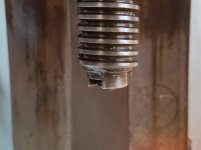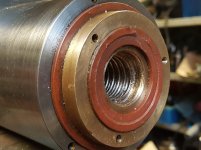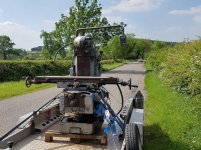Hopefuldave
Cast Iron
- Joined
- Apr 1, 2010
- Location
- Surrey, England
I've today lifted the knee on my Mill of Mystery, an Italian 1960s Testa 2U (I've only heard of one other in captivity), as I'd stupidly run it up to the point where the screw and nut disengaged, damaging the top thread of the bronze nut - all came apart pretty easily, and when I lifted the nut housing out of the base I discovered about 12" of bronze male thread and that someone has been there before me... (Why can nobody trouble themselves to find a screwdriver that fits the slots??)

I assume that this (which is locked up solid) should also rotate, when the end of the (steel) elevating screw is reached, to give more elevation and that this is what has caused the screw to run out of the bronze nut...
End of the (inner, power-driven) elevating screw looks like there's room for a stop to butt against the bottom of the bronze screw's inner thread

And the damage done - looks like this has happened before and someone before me has "cleaned up" the top turn of the thread, I'll do the same as there's still nearly 2" of 5 TPI bronze Acme left in there

Both threads are the same 5 TPI, so there'll still be the same travel whether or not the nut rotates in its housing, but allowing the nut to screw in and out of the base should (I think) allow the full range of movement - anyone care to shoot me down in flames? I'll have to apply some BF&I to the nut to get it rotating in the housing, but it *should* simplify reassembly as I'll be able to screw the nut up to meet the elevating screw, attaching the stop to the bottom of the screw may be interesting though...
Thanks in advance for any suggestions, cautions, encouragement!
Dave H. (the other one)

I assume that this (which is locked up solid) should also rotate, when the end of the (steel) elevating screw is reached, to give more elevation and that this is what has caused the screw to run out of the bronze nut...
End of the (inner, power-driven) elevating screw looks like there's room for a stop to butt against the bottom of the bronze screw's inner thread

And the damage done - looks like this has happened before and someone before me has "cleaned up" the top turn of the thread, I'll do the same as there's still nearly 2" of 5 TPI bronze Acme left in there

Both threads are the same 5 TPI, so there'll still be the same travel whether or not the nut rotates in its housing, but allowing the nut to screw in and out of the base should (I think) allow the full range of movement - anyone care to shoot me down in flames? I'll have to apply some BF&I to the nut to get it rotating in the housing, but it *should* simplify reassembly as I'll be able to screw the nut up to meet the elevating screw, attaching the stop to the bottom of the screw may be interesting though...
Thanks in advance for any suggestions, cautions, encouragement!
Dave H. (the other one)





